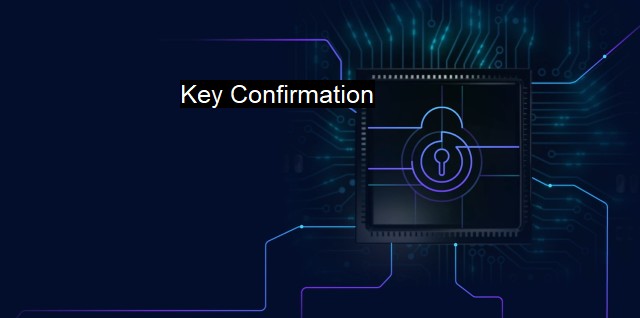What is Key Confirmation?
Key Confirmation: A Critical Defense Against Cybersecurity Threats in the Digital Age
Key confirmation refers to a critical component within the broad field of cybersecurity. It is an integral principle of secure communication, often deployed as an essential feature of encryption algorithms in modern security systems. Encryption is a powerful defensive tool in transmitting sensitive data, and key confirmation plays an integral role in guaranteeing the effectiveness of this process.The term "key confirmation" derives from the use of cryptographic keys in cybersecurity. These keys, which may be viewed as codes, are utilized in the symmetric (where the same key is used for encryption and decryption) or asymmetric (where the public key is used for encryption and the private key for decryption) encryption process to alter the data being sent, transforming it into a form which can only be understood if the recipient possesses a corresponding decryption key. Key confirmation comes into being in this context, where it is the method that enables the sender and recipient to confirm they share the same secret key, without revealing the key itself.
Key confirmation is particularly crucial owing to the fact that it gives both parties involved in the communication the assurance that they possess the same secret key and their data would not be intercepted or decrypted by unauthorized parties or entities. It forms a part of key-establishment protocols, which are required to generate or establish fresh keys for use in cryptographic systems. Key establishment protocols, combating potential "Man-in-the-middle" attacks, collaborate with key confirmation to confirm the use of the correct secret key, hence certifying that the established shared keys are known only to the legitimate participating entities
The procedure of Key Confirmation operates in the following steps. Firstly, based on a pre-shared secret key, each peer of the communication generates a derived key. Secondly, every peer encrypts a known value with the derived key and sends the result to each other. Lastly, each peer, upon receiving the encrypted known value, decrypts it with their own derived key, and if the decryption leads to the correct known value, it proves the key confirmation, ensuring them that they are using the correct key with the right communication peer.
It is insightful to make note of another aspect of key confirmation, termed unilateral or mutual key confirmation. Unilateral key confirmation allows one party to be sure the other party shares the same secret key. On the other hand, mutual key confirmation allows both participants to be aware they share the same secret key. Unilateral key confirmation can be advantageous; mutual key confirmation presents a stronger level of certainty over shared secret keys.
Key confirmation is a prerequisite in certain security protocols, especially in financial systems or military-grade communications, where it is vital that encrypted data does not fall into the wrong hands. Recently, various prototypes of key confirmation protocols have been made that embody efficient test areas of how beneficial mutual key confirmation is, and the functionality that it is designed to achieve.
The critical role that key confirmation performs in cybersecurity has been highlighted by an increase in difficulty in protecting sensitive data due to rapid advancements in computational power and hacking methodologies. Still, it plays a big role in reducing risks and ensuring a secure environment to share sensitive data, making it an integral component of strong, secure communication.
In conjunction with antivirus software, which tackles the menace of harmful software attempting to compromise a system, techniques such as key confirmation serve to create a formidable line of shield against a wide array of cyber threats, standing at the heart of effective cybersecurity mechanisms. For the growing digital world, security systems, including antivirus and key confirmation checks, will always be crucial in keeping ahead of those who aim to compromise security and confidentiality.

Key Confirmation FAQs
What is key confirmation in cybersecurity and antivirus?
Key confirmation refers to the process of verifying the authenticity of a cryptographic key before it is used to encrypt or decrypt data.Why is key confirmation important in cybersecurity and antivirus?
Key confirmation is important because it ensures that the cryptographic key being used is genuine and has not been tampered with, which helps prevent unauthorized access to sensitive data.What are the common methods of key confirmation in cybersecurity and antivirus?
The common methods of key confirmation include digital signatures, message authentication codes (MACs), and public key infrastructure (PKI) certificates.How does key confirmation help protect against malware attacks in cybersecurity and antivirus?
Key confirmation helps protect against malware attacks by preventing the malware from using fake cryptographic keys to encrypt or decrypt data, which can lead to data theft or data loss.| | A | | | B | | | C | | | D | | | E | | | F | | | G | | | H | | | I | | | J | | | K | | | L | | | M | |
| | N | | | O | | | P | | | Q | | | R | | | S | | | T | | | U | | | V | | | W | | | X | | | Y | | | Z | |
| | 1 | | | 2 | | | 3 | | | 4 | | | 7 | | | 8 | | |||||||